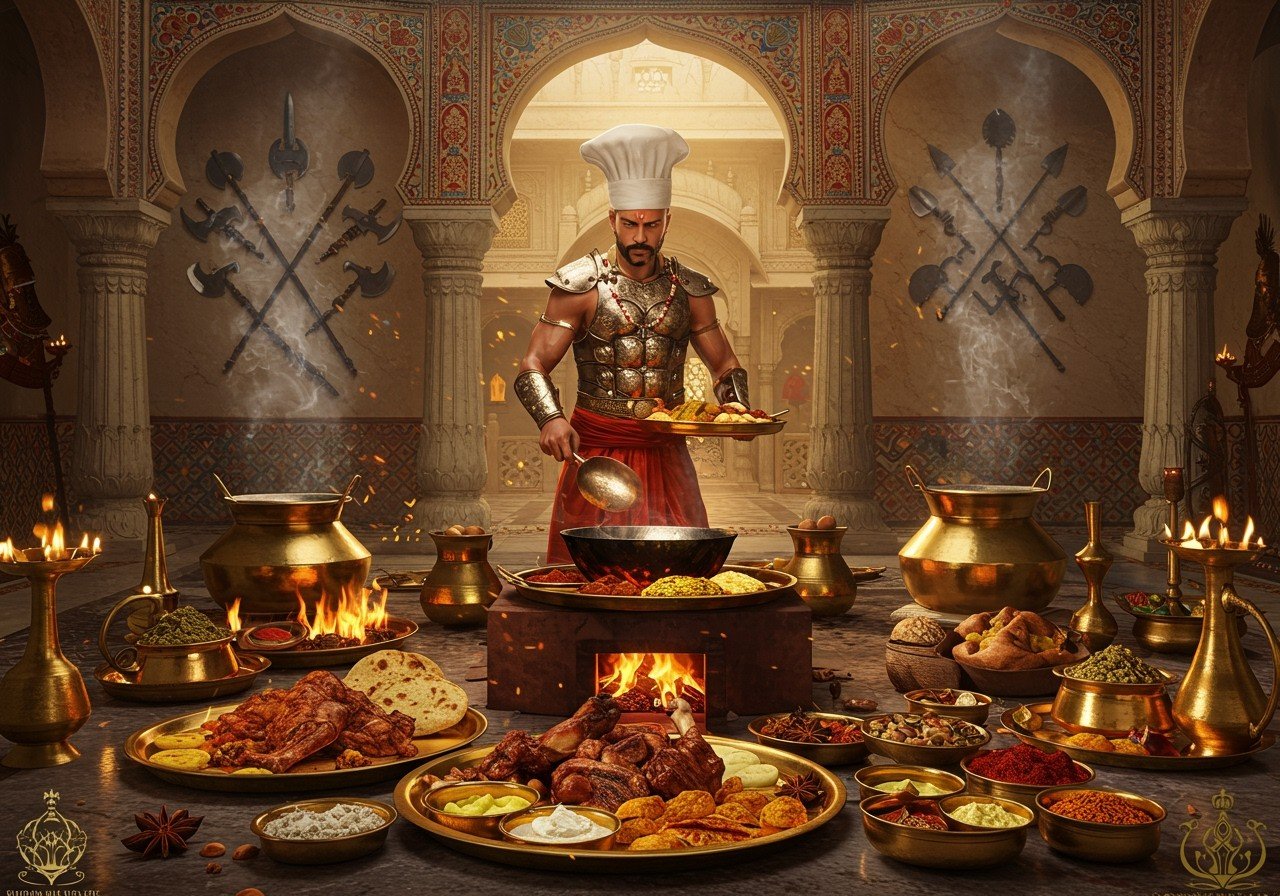
The Kshatriya diet is a captivating aspect of India’s diverse culinary heritage. Historically, Kshatriyas, the warrior class in Hinduism, followed a diet designed to fuel their demanding lifestyle. Let’s delve into the intriguing world of Kshatriya food, exploring its historical context, regional variations, and cultural significance.
Historical Context and Practices
Contrary to some beliefs, Kshatriyas weren’t strictly forbidden from consuming meat. This was rooted in practicality – warriors needed to maintain their strength and resilience, especially in challenging circumstances where meat could be a vital source of sustenance. While meat was permissible, there were often specific guidelines regarding the types of animals that could be consumed and the methods of slaughter, emphasizing respect for life and the avoidance of unnecessary cruelty. Hunting was sometimes considered acceptable, but primarily for sustenance rather than sport or leisure. Interestingly, over time, with the rise of dairy farming and horticulture, vegetarianism gained traction among Kshatriyas, possibly influenced by evolving health considerations and the growing influence of non-violent philosophies.
Diverse Perspectives on Diet
It’s important to note that not all Kshatriyas consumed meat. Some families, particularly those whose family deity (Kuldevta) was a Vishnu avatar, leaned towards vegetarianism. The concept of karma and the potential negative consequences associated with taking a life also played a role in some Kshatriyas’ dietary choices. Ancient texts like the Mahabharata and Ramayana offer glimpses into the dietary practices of Kshatriyas, sometimes referencing meat consumption, especially during times of necessity or survival. Bhishma, a revered figure in the Mahabharata, declared that Kshatriyas did not incur sin by consuming meat obtained through hunting. The Manu Smriti, while mentioning permissible animals for consumption, recommended performing specific rituals before partaking in meat.
Regional Variations
Kshatriya culinary traditions are as diverse as India itself, varying across regions and reflecting local ingredients and cultural influences. While specific dishes may differ, the underlying principles of providing wholesome, energizing meals remain consistent.
-
Kakinada: Known for its coastal location, Kakinada’s Kshatriya cuisine often incorporates seafood. Traditional dishes like *Royyala Iguru* (a prawn curry) and *Pottelu* (savory rice cakes) are local favorites, showcasing the region’s unique flavors.
-
Madhapur: Madhapur’s Kshatriya cuisine offers a blend of traditional and contemporary influences. Dishes like *Kunda Chicken* and *Gongura Mutton* represent the region’s culinary creativity.
-
Rajahmundry: Situated near the Godavari River, Rajahmundry’s Kshatriya food benefits from the region’s fertile lands. Dishes like *Pulasa Pulusu* (fish curry) and *Kodi Vepudu* (spicy chicken fry) are local specialties.
Modern Considerations
In today’s world, health awareness and personal beliefs significantly influence dietary choices. Some individuals believe that avoiding meat is beneficial for overall health. Historically, the consumption of hunted meat was sometimes linked to developing aggressive instincts deemed necessary for warriors, a concept less relevant in modern society.
Explore Sattvic Diets: A Culinary Exploration of Indian Cuisine
How Poojn.in Supports Your Kshatriya Food Traditions
At poojn.in, we understand the importance of honoring traditions. We offer a curated selection of items essential for preparing and serving traditional Kshatriya foods with the appropriate ritualistic reverence. Our Holy Food section features a range of products carefully chosen to align with Kshatriya dietary customs and ceremonial needs.
We offer:
-
Pure brass and copper utensils from our collection of 40+ Holy Utensils. These traditional utensils add a touch of authenticity to your culinary practices.
-
Traditional pooja samagri required for food offerings and rituals. Ensure your offerings are made with the purest ingredients and utmost respect.
-
Complete pooja kits for specific ceremonies involving food offerings. Simplify your preparations with our comprehensive kits containing everything you need.
-
Sacred items needed for food-related rituals, helping you maintain the sanctity and significance of your traditions.
To explore our complete range of Holy Food products and bring authenticity to your Kshatriya food traditions, visit https://www.poojn.in/product-category/poojn-stores/holy-food or contact us at:
- Phone: 03369029784
- WhatsApp: 9476142738
We offer delivery across India, and you can also visit our store in Boardangi, East Belbari, Gangarampur, South Dinajpur for direct purchases.
Celebrating Kshatriya Cuisine Today
Kshatriya cuisine transcends mere sustenance; it represents a profound connection to history, heritage, and cultural identity. It embodies a delicate balance of strength and spirituality, honoring the legacy of the warriors while adapting to contemporary values. By understanding, appreciating, and sharing these culinary traditions, we keep the spirit of the Kshatriyas vibrantly alive.
Whether you savor rich, protein-centric dishes or embrace a vegetarian approach, Kshatriya cuisine offers something unique and meaningful. It’s a reminder of the courage, discipline, and dedication of the warriors, inviting us to celebrate a heritage that values both strength and compassion. As we continue to prepare and enjoy these meals, we forge a tangible link to our roots, honoring our ancestors and enriching our future.
FAQs About Kshatriya Foods
What distinguishes Kshatriya cuisine? Kshatriya cuisine encompasses the traditional foods and culinary practices of the Kshatriya warrior class in India. Renowned for its rich, flavorful dishes, Kshatriya food often features meats, aromatic spices, and distinctive preparation methods that reflect their historical way of life.
Where can one experience Kshatriya foods in Kakinada, Madhapur, or Rajahmundry? In these cities, numerous local restaurants specialize in traditional warrior cuisine, offering a diverse array of dishes that showcase the rich heritage and distinct flavors of Kshatriya culinary traditions.
Does Kshatriya cuisine accommodate vegetarian preferences? Absolutely! While Kshatriya cuisine is often associated with meat dishes, there are plentiful vegetarian options available, including flavorful vegetable curries and other dishes prepared with traditional spices and cooking methods, offering a delightful taste of this warrior culinary heritage.
What are some popular Kshatriya culinary creations? Popular Kshatriya dishes often include hearty meat curries, succulent kebabs, and fragrant biryanis, all prepared with a medley of spices that create bold and satisfying flavors.
How does Kshatriya food reflect Indian culture? Kshatriya food serves as a culinary mirror reflecting Indian culture through its use of traditional spices, time-honored cooking techniques, and the stories it tells of the warrior class’s history and lifestyle, showcasing the rich tapestry of Indian culinary traditions.
Looking to enhance your pooja experience? Discover a wide variety of authentic pooja items at https://www.poojn.in/product-category/pooja-samagri.


